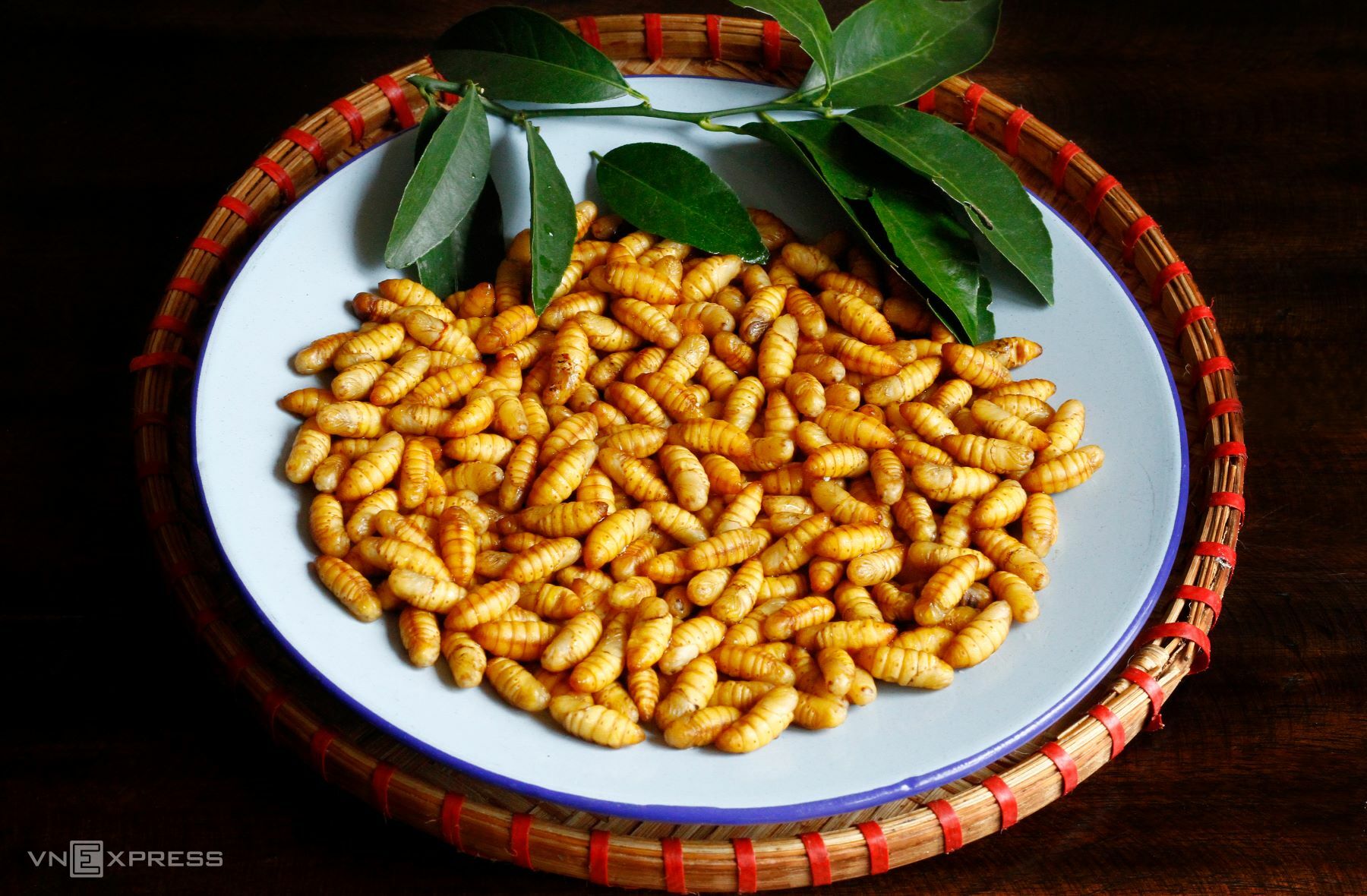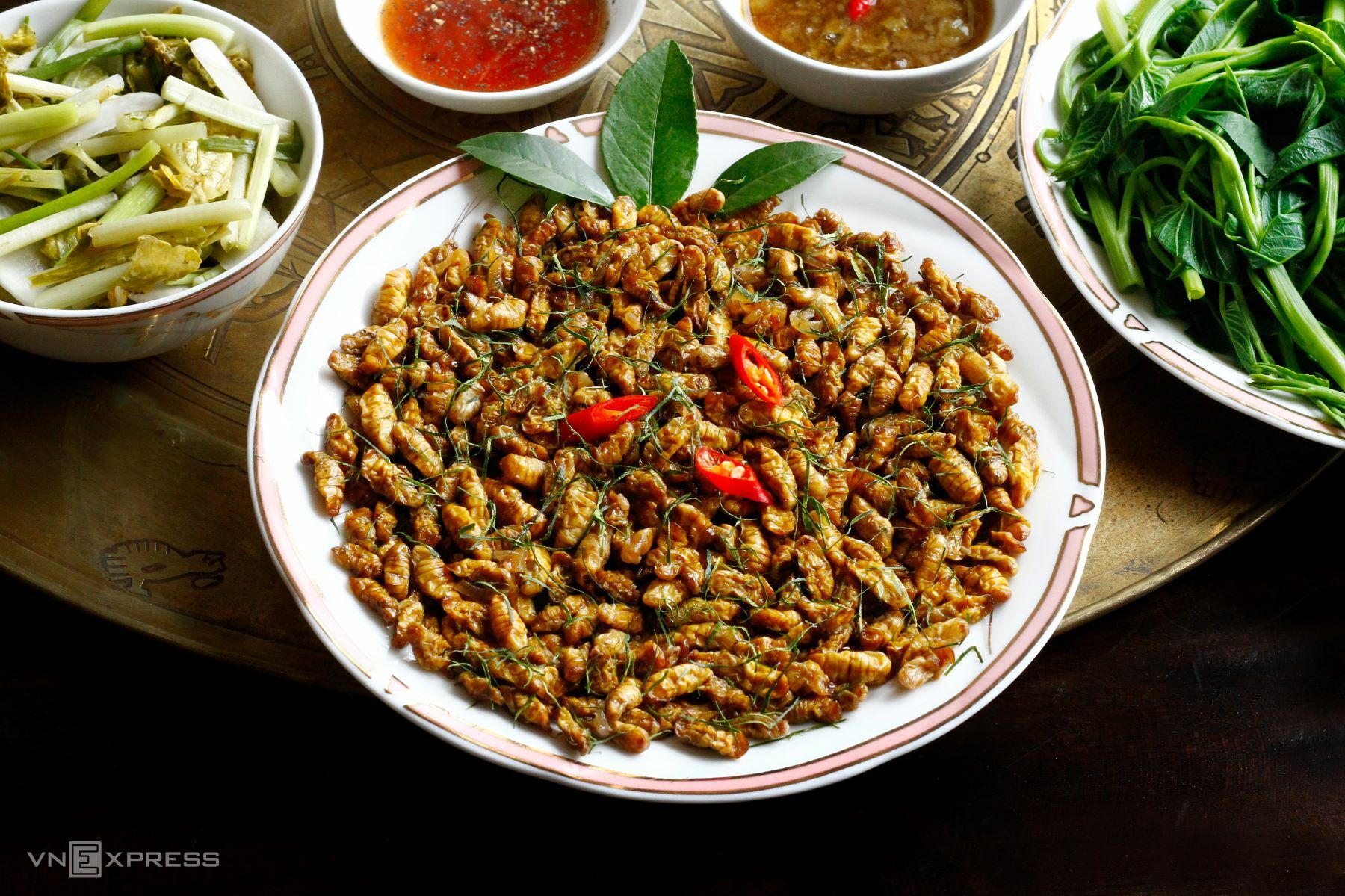A few folk tips can help make the dish more enjoyable.
According to traditional medicine, silkworm pupae are cooling, sweet, and nutritious but can easily cause stomach upset, bloating, itching, or rashes, especially for those with weak spleen and stomach systems.
Modern medical research shows that silkworm pupae contain unusual proteins like sericin, chitinase, and paramyosin, which can trigger allergic reactions, hives, and even anaphylactic shock in sensitive individuals. This is why this nutritious dish needs careful preparation to reduce the risk of irritation.
 |
Delicious silkworm pupae are small, yellow, shiny, and have segments close together. Photo: Bui Thuy |
Folk wisdom suggests adding lime leaves or a little pickled cucumber or mustard green brine when roasting silkworm pupae. Traditional medicine explains that lime leaves have a warming, aromatic nature, helping to cleanse, move qi (vital energy), and aid digestion. The yin-yang and five elements theory in Vietnamese cuisine has always emphasized the harmony between hot and cold, dry and wet elements. Dishes that are too cooling can harm the spleen and stomach, especially for those with a cold constitution or during seasonal changes. Adding a few shredded lime leaves to balance the cooling nature of the pupae with the warming properties of the spice makes the dish easier to digest and reduces the risk of allergies.
Studies show that lime leaves contain essential oils like limonene, citronellal, and linalool, compounds with antibacterial and anti-inflammatory properties that can soothe sensitive reactions. Adding shredded lime leaves near the end of roasting allows the essential oils to be released and blend in, creating a characteristic aroma and mitigating the effects of some allergy-causing proteins in the pupae.
In addition to shredded lime leaves at the end, many housewives in northern Vietnam also share the secret of adding a small spoonful of pickled cucumber or mustard green brine when the pupae start to firm up. The mild sourness and saltiness from the fermented brine not only reduces the fishy smell but also enhances the flavor of the pupae and limits allergic reactions.
Pickled cucumber or mustard green brine is a naturally fermented food, rich in beneficial bacteria, capable of neutralizing the cooling nature of the pupae, supporting the intestines, and reducing the risk of bloating and indigestion. From a scientific perspective, the organic acids and enzymes in the brine can contribute to the mild breakdown of allergy-causing proteins while creating a harmonious, palatable flavor.
 |
Roasting silkworm pupae with lime leaves balances the flavor and reduces the risk of allergic reactions. Photo: Bui Thuy |
To create delicious, non-fishy roasted pupae and avoid allergic reactions, keep the following points in mind.
When buying, choose mulberry leaf-fed silkworm pupae that are small, yellow, shiny, with segments close together, and feel fresh and soft to the touch. Avoid buying large, pale yellow hybrid pupae that may be treated with chemicals. Also, avoid dark, loose-segmented pupae, as the decomposed protein can be toxic and lack nutritional value.
When roasting, initially add salt and enough water to almost cover the pupae in a pot or pan and bring to a boil. After a few minutes, reduce the heat and continue simmering uncovered until the water evaporates. Then, turn off the heat and set aside. Simmering with salt water enhances the flavor, removes the fishy smell, and helps prevent allergic reactions.
Saute chopped shallots in lard, then add the pupae and stir-fry over medium-low heat until the fat coats them evenly. At this point, the pupae will become glossy and release a characteristic aroma. When they turn golden brown with a crackling sound and a fragrant smell, add a little fish sauce, pickled cucumber or mustard green brine, and MSG (optional) to taste, stirring a few times. Finally, add shredded lime leaves, stir, turn off the heat, and enjoy hot. Use naturally fermented, not too sour, clear, and fragrant pickled cucumber or mustard green brine.
Just a few shredded lime leaves and a spoonful of pickled brine added to the roasted pupae demonstrate the subtle understanding of traditional Vietnamese cooking, creating a dish that is both delicious and healthy. This is the art of combining flavor, texture, the five elements, cuisine, and folk medicine to make the rustic silkworm pupae dish palatable, nutritious, and suitable for Vietnamese tastes.
Bui Thuy












